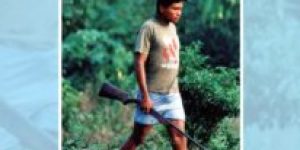Journal Of Anthropological Films
No Comments yet![]() Film cameras, video and sound recorders have for decades been used by anthropologists as research tools, for collecting data, for documentation, for advocacy, for representing a case or a group of people, for disseminating empirical insights and for communicating research findings. For the first time in the history of Visual Anthropology anthropological film can now be published on par with written articles, assessed by peers, and inscribed in international credential systems of academic publication as the Nordic Anthropological Film Association (NAFA) has launched this first edition of Journal of Anthropological Films (JAF)
Film cameras, video and sound recorders have for decades been used by anthropologists as research tools, for collecting data, for documentation, for advocacy, for representing a case or a group of people, for disseminating empirical insights and for communicating research findings. For the first time in the history of Visual Anthropology anthropological film can now be published on par with written articles, assessed by peers, and inscribed in international credential systems of academic publication as the Nordic Anthropological Film Association (NAFA) has launched this first edition of Journal of Anthropological Films (JAF)
Go to: http://boap.uib.no/index.php/jaf/index
Editorial
The Nordic Anthropological Film Association (NAFA) has launched the Journal of Anthropological Films (JAF)
Film cameras, video and sound recorders have for decades been used by anthropologists as research tools, for collecting data, for documentation, for advocacy, for representing a case or a group of people, for disseminating empirical insights and for communicating research findings. For the first time in the history of Visual Anthropology anthropological film can now be published on par with written articles, assessed by peers, and inscribed in international credential systems of academic publication as the Nordic Anthropological Film Association (NAFA) has launched this first edition of Journal of Anthropological Films (JAF) published by Bergen Open Access Publishing (BOAP).
JAF publishes films that combine documentation with a narrative and aesthetic convention of cinema to communicate an anthropological understanding of a given cultural and social reality. JAF publishes films that stand alone as a complete scientific publication based on research that explore the relationship between “contemporary anthropological understandings of the world, visual and sensory perception, art and aesthetics, and the ways in which aural and visual media may be used to develop and represent those understandings” to borrow words from Paul Henley (in Flores, American Anthropologist, Vol 111, No.1, 2009:95). While most films will stand for themselves, only accompanied by an abstract, supplementary text will be accepted when it adds productively to the anthropological analysis and in case the peer-reviewers will ask for it.
Reviews of entries for JAF will assess the film’s ability to communicate social and cultural analysis and to explore and develop anthropological methodologies and film genres. The anthropological approach to fieldwork very much goes along with the ideas of observational cinema, and this genre still inspires much anthropological filmmaking today. However, theories and ideas generated within the discipline influence on what modes of representation will be relevant and how written text and film interplay. Reflexivity was an issue within visual anthropology years before feminism and later postmodernism made it a concern for mainstream anthropology. Postmodernism, furthermore, focused on ethnography and the particular, more than on abstraction and generalisation, and these ideas work well with visual anthropology. The later so-called ontological turn within anthropology also opens for interesting contributions from visual anthropology as film can give voice to the protagonists, share their experiences, the activities, the rhythm and sound of their life, their ideas and understandings and how they interpret aspects of their culture. Today technologies develop at a rapid speed and offer still better technical solutions for using audio visual means to collect anthropological information, conduct anthropological analysis, and develop the field of Visual Anthropology.
The films published in this first edition of JAF, represent near all continents and deal with various anthropological themes, such as local politics, climate change, gentrification, cultural heritage, gender, castes, religion, as well as methods and theories on representation. Each film is a unique representation of a particular place and people combining documentation with an anthropological narrative.
The Fish that Disappeared by Bjørn Arntsen (Norway), based on research among fishermen on the Cameroon side of lake Chad, deals with issues on climate change, local politics and what Garrett Hardin (Science, Vol 162, 1968) once labeled Tragedy of the Commons. The film shows the dilemma of people finding ways around governmental regulations of the resources to make a living from the lake. Bente Sundsvold’s (Norway) To Think Like a Bird, is a full-length feature film on cultural heritage. The film follows a woman activist and shows the reciprocal practices of people and birds using the tradition of manmade huts in eider conservation. Grabbing Dignity by Cristian Felipe Roa Pilar, (Chile, Denmark) is a film on moving people by force before destroying illegal settlements. This is a hot political issue, not at least in South America. The film focuses on women and their dignity in this relocation process. In Nepal the government abandoned the caste system by law already in 1963. Still the system is very much part of peoples everyday life. Why Dalit, by Berit Madsen, (Denmark) shows the situation from the point of view of the Dalit, the untouchables, as well as seen from the higher castes.
The Possibility of Spirits, by Mattijs Van de Port (The Netherlands) is not an ethnographic film in a traditional way, but an explicit, self-reflexive exploration into the mystery of spirit possession. The kind of experimental film, based on material from Bahia, Brazil, is also a critic of the observational ethnographic film genre. JAF therefore publishesBetween Islam and the Sacred Forest by Martin Gruber and Frank Seidel (Germany), which is an observational film exploring two ceremonies of different traditions. The film, shot in Guinea, West Africa, follows closely the ceremonies step by step in a chronological order. It is also a self-reflexive film involving the filmmakers as part of the narrative as they try to catch and understand what goes on. The two films approach related anthropological themes from using different theoretical perspectives and demonstrate how visual anthropology and filmmaking can contribute to debates within the discipline of anthropology.
JAF will first of all publish films that present new empirical and theoretical insights within the field of anthropology. Many of the films may inspire comments and debates on particular or general anthropological issues. JAF will open for such debates, where also edited versions of reviews and filmmakers’ replies, may be included. We look forward to feedbacks and inputs, so please get in touch with the editorial staff if you have any suggestions for JAF. Enjoy the films.
You May Also Like
Comments
Leave a Reply





